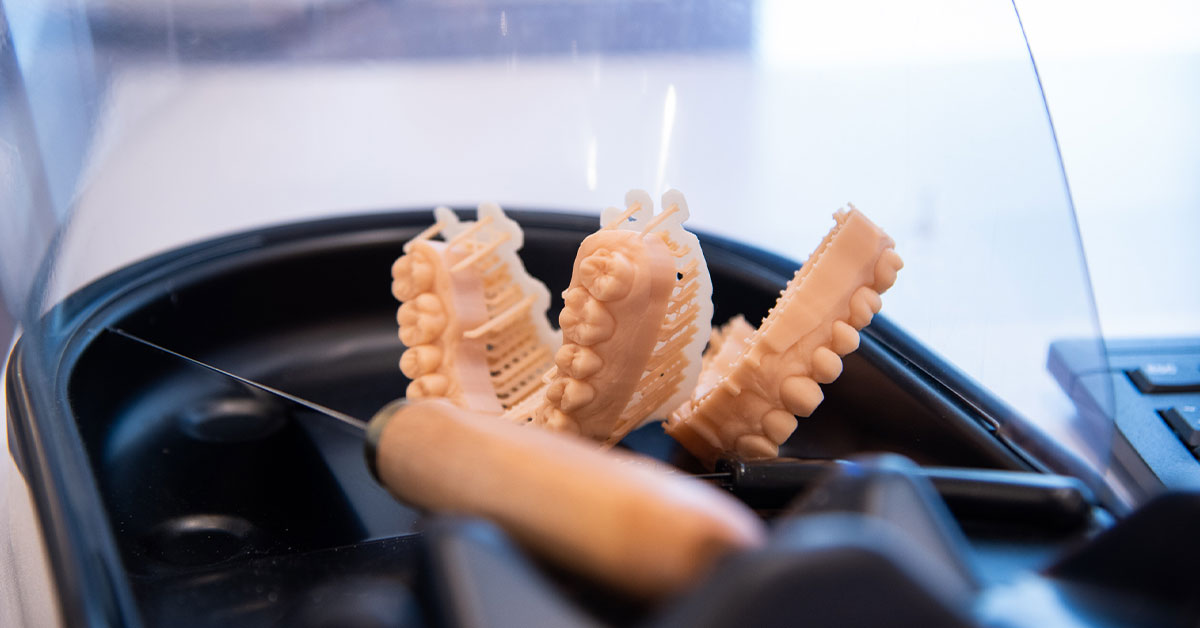
As with many dental laboratories, dental practices have adopted the 3D printing process for the production of dental applications. Dental 3D printing can be easily integrated into digital dentistry workflows, including intraoral scanners, CAD/CAM software and milling units. 3D printing has matured from prototyping, offering new opportunities for practices and laboratories to work precisely and efficiently.
Primeprint from Dentsply Sirona is a 3D printing solution that includes not only 3D printing but also automated post-processing. Combined with advanced software, Primeprint allows for a wide range of applications and offers users an extension of treatment and service offerings. The highly automated and intelligent interaction between software and hardware enables the production of biocompatible indications with accurate, reproducible and medical-grade results.
In the following case study, Mike Skramstad, DDS, shares how Primeprint fits within his existing digital workflow to produce a 3D-printed wax-up and Primeprint Model resin to show the patient what the finished procedure would look like while also creating guides, temporaries and a Biocopy for final restorations.
Case description
A 47-year-old female presented to my office with concerns about six anterior zirconia crowns recently done at another office. She felt they were poorly shaped and crooked to her face and described what we as dentist refer to as a reverse smile line and lack of flow. She also complained of tooth sensitivity and occlusion that was not even and bothered her on a daily basis.
After initial consultation, photographs and intraoral scans with Primescan AC were taken to perform a comprehensive consultation. Having the digital impressions and photographs help visually discuss her concerns and create value for pursuing treatment. After the plan was finalized, all scans and pictures were sent to our laboratory to create a virtual wax-up. After finalization, I 3D printed the wax-up with Primeprint and Primeprint Model resin. This physical model of the plan allowed me to present a
preview of treatment to patient, create preparation guides, make proper temporaries, and use as a Biocopy for final restorations. To finalize the proposed plan, we transferred the wax-up to the mouth with bis-acryl material at the second appointment. She approved and was excited for treatment. On appointment three, I prepared full coverage crowns on tooth #6-11 and veneers on tooth #5 and #12. We scanned the final preparations, opposing dentition, 3D printed diagnostic wax-up in the Biocopy Folder, and Buccal Bite with Primescan AC. After margination of the preparations in the CEREC 5.2.3 software, we sent case to inLab SW 22. This software allowed us to create a solid model (with ditched dies) and a working model with removable dies. This completed model data was sent to inLab CAM 22 and 3D printed with the Primeprint out of Primeprint Model resin. The efficiency and ease of use of
the Primeprint Solution allows me to quickly print models on the same day of treatment. The automation allows me to continue with my design work without having to worry about monitoring the printing process, manually cleaning resin, or dealing with messy alcohol. It took approximately 50 minutes to print both the solid and working model and under 45 minutes to wash and cure. After final design, all restorations were produced out of glass ceramic with CEREC Primemill using the extra-fine mode. The restorations were then bonded into place using Calibra resin cement. The patient was delighted with the final result.
Discussion
Technology – like 3D printing – is rapidly changing the way dentists work. The beauty of 3D printing is that any last-minute changes to models, removable dies, wax-ups etc. can be made quickly and easily, just by 3D printing another one in a very short period of time. This agile way of working helps to streamline workflows, especially when executing cosmetic treatments. It ensures that restorations will need minimal to no functional or cosmetic adjustments when seated. Technology and equipment like Primescan AC, Primeprint Solution, inLab software were pivotal in helping me give the patient a healthy smile.
About Dr. Skramstad
Dr. Michael Skramstad is a dentist at Orono Dental Care in Orono, Minnesota. With a bachelor’s degree in genetics from Purdue University and a Doctor of Dental Surgery from the University of Minnesota School of Dentistry, Dr. Skramstad performs all aspects of cosmetic, implant and family dentistry with a particular focus on esthetic and CAD/CAM dentistry. He is a certified Advanced Trainer for Patterson Dental and has lectured internationally on technology and digital dentistry. Dr. Skramstad is an Alpha tester for Sirona Dental Systems, focusing on the production of digital restorations. A product consultant for multiple dental companies, he has tested and evaluated many products prior to market launch and has published numerous articles on dental materials and CAD/CAM.
– – –
Case study courtesy of Dentsply Sirona.

















You must be logged in to post a comment.